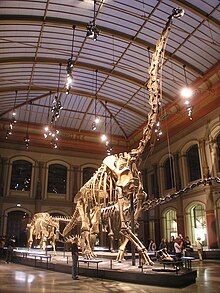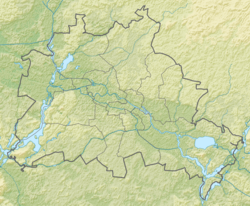Museum für Naturkunde
muzeo en Germanio
La Berlina Muzeo de Natura Historio (germane Museum für Naturkunde (MfN), foje nomata la Naturkundemuseum aŭ Humboldt Museum mallongige; oficiale: germane Museum für Naturkunde – Leibniz-Institut für Evolutions- und Biodiversitätsforschung an der Humboldt-Universität zu Berlin) estas naturhistoria muzeo en Berlino, Germanio. Tiu muzeo estas hejmo de pli ol 30 milionoj da zoologiaj, paleontologiaj, kaj mineralogiaj specimenoj, inklude pli ol dekmilo da tipaj specimenoj. Ĝi famas pro du spektaklaj montraĵoj: nome la plej granda muntita dinosaŭro en la mondo, kaj tre bone konservita specimeno de la plej frua konata birdo, nome Archaeopteryx.
| Museum für Naturkunde | |||||
|---|---|---|---|---|---|
| Museum für Naturkunde | |||||

| |||||
 | |||||
| muzeo de natura historio muzeo natura historio esplora institucio universitata muzeo (–2008) | |||||
| Lando | Germanio vd | ||||
| Situo | Berlin-Mitte | ||||
| Situanta sur | Invalidenstraße | ||||
| Estiĝo | 1810 | ||||
| Malfermo | 2-a de decembro 1889 | ||||
| Direktoro | Johannes Vogel • Reinhold Leinfelder | ||||
| Koordinatoj | 52° 31′ 49″ N, 13° 22′ 45″ O (mapo)52.530213.3792Koordinatoj: 52° 31′ 49″ N, 13° 22′ 45″ O (mapo) | ||||
| |||||
| Parto de | Humboldt-Universitato en Berlino • Lejbnico-Asocio vd | ||||
| |||||
| Retpaĝo | https://www.museumfuernaturkunde.berlin | ||||


Notoj
redaktiReferencoj
redakti- Olshevsky, G. (1991). “A Revision of the Parainfraclass Archosauria Cope, 1869, Excluding the Advanced Crocodylia”, Mesozoic Meanderings #2 1 (4), p. 196 pp.
- Paul, G. S. (1988). “The brachiosaur giants of the Morrison and Tendaguru with a description of a new subgenus, Giraffatitan, and a comparison of the world's largest dinosaurs”, Hunteria 2 (3), p. 1–14.
- Maier, Gerhard. African dinosaurs unearthed : the Tendaguru expeditions. Bloomington, Indiana : Indiana University Press, 2003. (Life of the Past Series).
Eksteraj ligiloj
redakti- Museum für Naturkunde (retejo)
- Naturkundemuseum Berlin seeks sponsors for a hoard of world heritage treasures, de Eva-Maria Levermann el Goethe-Institut
- Historio de Humboldt-Universität zu Berlin
- Foto de Berlina specimeno de Archaeopteryx Arkivigite je 2007-04-27 per la retarkivo Wayback Machine
- Historio de mineralogiaj kolektoj ĉe la Muzeo de Natura Historio en Berlino
- Time-lapse filmo pri malmuntado de Braĥiosaŭro[rompita ligilo]
- Historio de la minerala kolekto Arkivigite je 2015-02-27 per la retarkivo Wayback Machine


